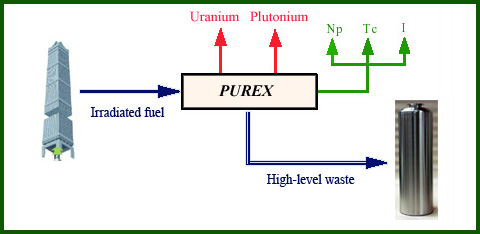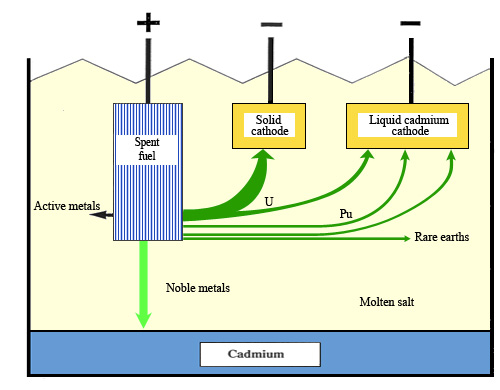Some prospects still a long way off

Neptunium, technetium and iodine separations ?
The partitioning of neptunium (Np), the most abundant but least radioactive minor actinide, would be relatively easy to do. Studies carried out at the ATALANTE pilot facility have shown that, by making minor changes to the PUREX process used at La Hague for extracting uranium and plutonium, it would be possible to partition this actinide. It would also be possible to separate the iodine (I) and the technetium (Tc), isotopes I-129 and Tc-99 of which are long-lived fission products.
© CEA
The main aim of partitioning and transmutation is to reduce the radioactive toxicity and amount of heat released by high-level waste (HLW) destined for deep geological disposal. This long-term effort only makes sense if nuclear energy is going to be used for at least a century. With this prospect, there are many high-level studies and technological developments that still need to be undertaken in view of the complexities of dealing with these highly radioactive materials.
The minor actinides have been the main target of research into partitioning, which has ranged from the basic aspects to its applications. Extractant molecules and extraction techniques have been successfully tested in the laboratory. The next stage, a pre-industrial phase, is in progress. There have already been some interesting findings as far as future nuclear systems are concerned. New prospects are offered by group partitioning of the actinides, an altogether different undertaking, the feasibility of which has not yet been established.
In its final report in January 2006, the French National Assessment Board (CNE) said that the technical feasibility of advanced partitioning had nearly been established but was not quite there yet: ‘The Atalante teams working on this demonstration have high hopes of its success. The Board is confident that this will be achieved soon but it would be premature to say that it can be envisaged industrially when the validation testing has only recently begun, in early 2005. The results achieved to date are not relevant to the group partitioning of the actinides, which has been advanced as a new possibility. This is an altogether different undertaking’.
said that the technical feasibility of advanced partitioning had nearly been established but was not quite there yet: ‘The Atalante teams working on this demonstration have high hopes of its success. The Board is confident that this will be achieved soon but it would be premature to say that it can be envisaged industrially when the validation testing has only recently begun, in early 2005. The results achieved to date are not relevant to the group partitioning of the actinides, which has been advanced as a new possibility. This is an altogether different undertaking’.
Industrial feasibility is about more than just whether something is technically feasible. A process like the partitioning of americium and curium must undergo an adequate period of testing under real conditions in a pilot plant. What are the prospects for this type of partitioning? Will it be necessary to wait for the renewal of the facilities at La Hague in 2040?
Will this large plant and France’s ‘put everything in glass’ strategy be an obstacle to subsequent partitioning and transmutation? Partitioning is expensive, and apart from adaptations to the current process in order to extract neptunium, the nuclear industry has no real reason to move away from a strategy that currently meets its needs.
The type of partitioning carried out at La Hague will carry on evolving and being improved as it has in the past. So what kind of partitioning will we actually need? 2040 is still a long way off. With most of the Generation IV systems set to take over from the current reactors, partitioning is envisaged as being carried out in the immediate vicinity of the reactor, which is very different from the centralised partitioning that takes place today at one main facility.

Molten salts separation
This separation consists in putting the elements to be partitioned in a high-temperature bath of molten salt. The elements of interest are selectively recovered using various chemical engineering techniques: extraction by molten metals, electrodeposition and precipitation. In this liquid medium, the effects of the radiation are limited. It is a compact system but there is as yet no knowledge of how well it will perform. The molten salt is highly corrosive and it will difficult to implement.
© CEA (Source: B.Boullis)
Outlook for 2040
What share of the energy mix is nuclear likely to represent by 2040? Renewables (solar, wind) will probably not be sufficient to meet energy demand, but the Generation IV reactors could be in competition with fusion reactors if research by the ITER project is successful. Fusion would generate little waste, and more specifically no actinides. If fusion gained an important share, work on reducing the toxicity of the actinides would no longer be needed.
According to the National Evaluation Board research into partitioning and transmutation should take account of the requirements of the nuclear industry of the future. Industrial deployment will depend on many factors such as the energy context, the importance of nuclear and ultimately the relevance and economic viability of partitioning and transmutation.’